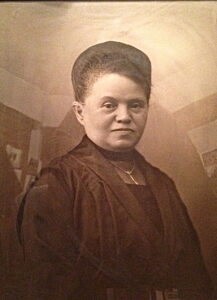
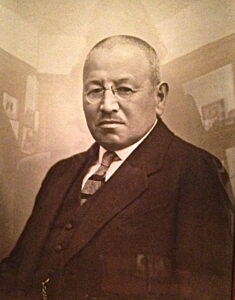 See:
See:
Rosa (née Wertheimer) & Jacob Edelmuth
Learning the Story of Rosa and Jacob Edelmuth
Milton and Bella (née Wertheimer) Wertheimer
The Frankenberg and Wertheimer Families
Both Nathan Wertheimer and Malwine Frankenberg were born in the same year, 1859, in the same village — Marisfeld close to Themar. Both families had roots in the village going back into the 1700s: Nathan’s grandfather was Jacob Samuel Wertheimer, b. 1768; Malwine’s grandfather was Nathan Jonas Frankenberg, b. 1770
On 20 July 1885, Nathan and Malwine married in Themar. Three children were born in Themar: Julius, b. 1886, Rosa, b. 1887, and Bella, b. 1890. The address we have for them is Mangersgasse 85, a few steps away from the central square.
The family of five moved from Themar to Coburg possibly in the early 1890s to join other family members, including Malwine’s parents, Jacob and Luise Frankenberg, who had retired to Coburg., Coburg was a much larger place than Themar: in the early 1900s the city had some 20,000 citizens, including 205 Jews; by 1925, the population total was 25,000 residents, including 316 Jews. Julius established himself as a butcher in the center of the city. Nathan identified himself as a businessman dealing in property, etc.
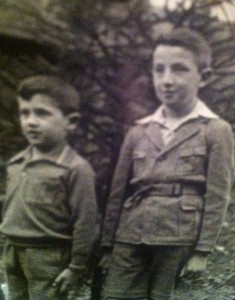
All three children married: Julius married Käthe Meinstein, b. 1896 in Zirndorf/Bavaria, and they had two sons, Heinz, b. 1926, and Aflred, b. 1929. Rosa married Jacob Edelmuth of Beuern (near Giessen), a businessman or ‘Kaufmann’. A daughter, Liselotte/Lotte, was born in 1913 in Halle/Saale; a son, Siegbert, was born in 1917 in Coburg. By the early 1920s, the family was living in Dessau at Franzstrasse 3-4. Bella married a cousin, Milton Wertheimer, b. 1886 in Themar, the son of Louis and Emma (née Frankenberg) Wertheimer. They lived in Coburg, although Milton travelled frequently to other places throughout Germany as far north as Bremen. Milton’s younger brother, Nathan, b. 1890 in Themar, also lived in Coburg, with his wife Elsa, née Frankenberg. Elsa was the daughter of Malwine’s brother, Max Frankenberg, and his wife, Meta Rosenthal, of Gleicherwiesen. Elsa’s brother, Arthur, was killed in 1917 in World War I. In 1925, Max Frankenberg died and was buried in the Coburg Jewish cemetery. In 1926, his sister Malwine died of diabetes complications and was also buried in the Jewish cemetery of Coburg.
The 1928 Coburg Address Book listed the Wertheimers living in Coburg at the following addresses and their occupations: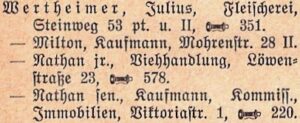
Julius Wertheimer, owner of a butcher shop at Steinweg 53; family lived in apartment in 2nd floor
Milton Wertheimer, Businessman, (and Bella, his wife), lived at Mohrenstr. 28, in 2nd floor apartment.
Nathan Wertheimer, jr. [Milton’s brother] and his family [Elsa and Edith], cattle dealer, lived at Löwenstrasse 23, and
Nathan Wertheimer, Sr,, real estate, lived at Viktoriastrasse 1. [Nathan Sr. was father of Julius and Bella Wertheimer, both residents of Coburg.] *****
*****
When the Nazi Regime began in January 1933, members of the family of Nathan and Malwine lived in various places in Germany: Nathan and the family of his eldest son, Julius, lived in Coburg; Bella was still in Coburg while Milton was moving from place to place within Germany. Rosa and Jacob Edelmuth and their two children were in Dessau.
The 1930s saw the family on the move — within Germany, within Europe and then outside of Europe altogether. Initially the reasons were a mix of personal and political: Lotte Edelmuth, the daughter of Rosa and Jacob, was the first to leave Germany — her purpose: marriage to Erwin Meder, b. 1906 in Frankfurt a/Main. Researcher Lisa van der Beek tells us that “Erwin Georg Sigfried Karl Meder had been in the Netherlands since the 1st of November 1926. Lieselotte arrived on the 5thof July 1933 from Halle{Salle], Germany. Her first address was Willemsparkweg 182 huis. She lived with Samuel van Maarssen, who often had people rent a room in his house. On the 1stof November 1933, Lieselotte Edelmuth married Erwin Georg Sigfried Karl Meder in Amsterdam. Samuel van Maarssen was one of the witnesses at the wedding of Erwin and Lieselotte.”
Lotte’s brother, Siegbert, followed her to Holland. His intent was to attend one of the training centres offering Jewish youth skills that would be useful in the three countries — Palestine, Argentina, and South Africa — that would accept them as immigrants.
 Nathan and son-in-law Milton Wertheimer moved within Germany. Neither man had an entry in the 1934 Coburg Address Book: in October 1934, Nathan Wertheimer, age 75, left Coburg and moved to Dessau to live with Rosa and Jacob Edelmuth.
Nathan and son-in-law Milton Wertheimer moved within Germany. Neither man had an entry in the 1934 Coburg Address Book: in October 1934, Nathan Wertheimer, age 75, left Coburg and moved to Dessau to live with Rosa and Jacob Edelmuth.
In January 1936, Milton Wertheimer left Germany and immigrated into Holland to live in Amsterdam. Bella Wertheimer, Milton’s wife, remained in Coburg, where she worked in the kitchen at ‘Hohe 30’, the boarding school for Jewish boys run by Hermann Hirsch.
Leaving Europe altogether started in the mid-1930s: Julius Wertheimer and his family were the first to seek refuge far away — on 3 June 1936, the family obtained their passports and visas to enter the United States and, on 24 June 1936, they sailed from Hamburg to New York City. sponsored by an uncle, Joseph Kaltenbacher. In 2014, Alfred Wertheimer visited Coburg and remembered their decision to leave:
“My father did not want to leave. He could not believe that the country for which he had been willing to lay down his life for, could be serious about eliminating the Jews from German life. As well, he had made significant investment into the property at Steinweg 53 and he did not simply want to leave it behind. In the end, it was my mother [Käthe Wertheimer], who laid down the law in 1936: ‘Julius,’ she decreed, ‘we are going!’ She packed their most treasured belongings and feather beds, organized support from a distant uncle for their entry visas into the States, and thus saved the lives of her family.”
Siegbert Edelmuth left sometime in the mid-to-late 1930s; having trained as a boiler maker, he chose South Africa as his next home.
We do not know when Rosa and Jacob Edelmuth, and Nathan Wertheimer, started planning to leave Germany; that is, whether they began before or after the harrowing events of the Reichspogromnacht of 9/10 November 1938. We do know that they left as quickly as possible after the Reichspogromnacht — on 13 January 1939, Jacob Edelmuth entered Holland; on 21 February, Rosa and her father, Nathan, followed. The three moved in with Lotte and Erwin Meder at Stadionstraat 19/1. On 1 May 1939, the five moved to an apartment on Slaakstraat 11 III.
*****
At the outbreak of WWII, only Bella Wertheimer (née Wertheimer) remained in Germany. Whether she was hoping to move to Holland to join her husband Milton, or perhaps to flee to America sponsored by her brother Julius, we do not know. On 9 November 1938, the Jewish school where she both lived and worked had been smashed, the school director, Hermann Hirsch, arrested and sent to Buchenwald, and the school closed. On 7 March 1939, Bella left Coburg and thereafter we find her bouncing back and forth between the towns of Marisfeld, Themar, Halle/Saale and Meiningen. When the Nazis halted voluntary emigration in October 1941, her fate was sealed. On 10 May 1942, Bella was rounded up in Meiningen and taken to Weimar and on to Belzyce Ghetto. She was murdered either in the ghetto or elsewhere close by in Distrikt Lublin. Bella was 52 years of age.
On 15 July 1942, the deportations from the Netherlands began: 1135 men, women, and children were deported from the transit camp, Westerbork, to Auschwitz. Two weeks after this transport — on 3 August 1942 — Nathan Wertheimer, age 83, died In Amsterdam at Stadhouderskade 153; the cause of death is unknown. Two months later, on 3 October 1942, Jacob Edelmuth and brother-in-law Milton Wertheimer were rounded up in Amsterdam and taken to Westerbork. Lotte, whose hair turned white overnight, went into hiding behind a wall built by Erwin in the apartment at Slaakstraat 11 III. Erwin Meder rode out to Westerbork as often as he could to see his father-in-law, entering the camp as an electrician.
On 21 April 1943, Jacob Edelmuth and Milton Wertheimer were brought from Westerbork to Amsterdam for deportation. Unlike other transports from Holland, which took Dutch Jews directly to the killing centres of Auschwitz or Sobibor, the purpose of this transport was to take German Jews living in Holland to the ghetto in Theresienstadt. The 286 German Jews were duped into believing that they were going to a retirement settlement. Rosa Edelmuth, who had not been sent to Westerbork, chose to accompany her husband on the transport.
But the promise of a retirement home in the ghetto was a snare and a delusion: four months after their arrival in Theresienstadt — on 6 September 1943 — Rosa and Jacob were transported from the Ghetto to Auschwitz; 6 months later, they were murdered. Milton remained in Theresienstadt until 9 October 1944. He was then transported to Auschwitz and murdered upon arrival. Rosa was 56 years of age, Jacob, 60, and Milton, 58.
*****
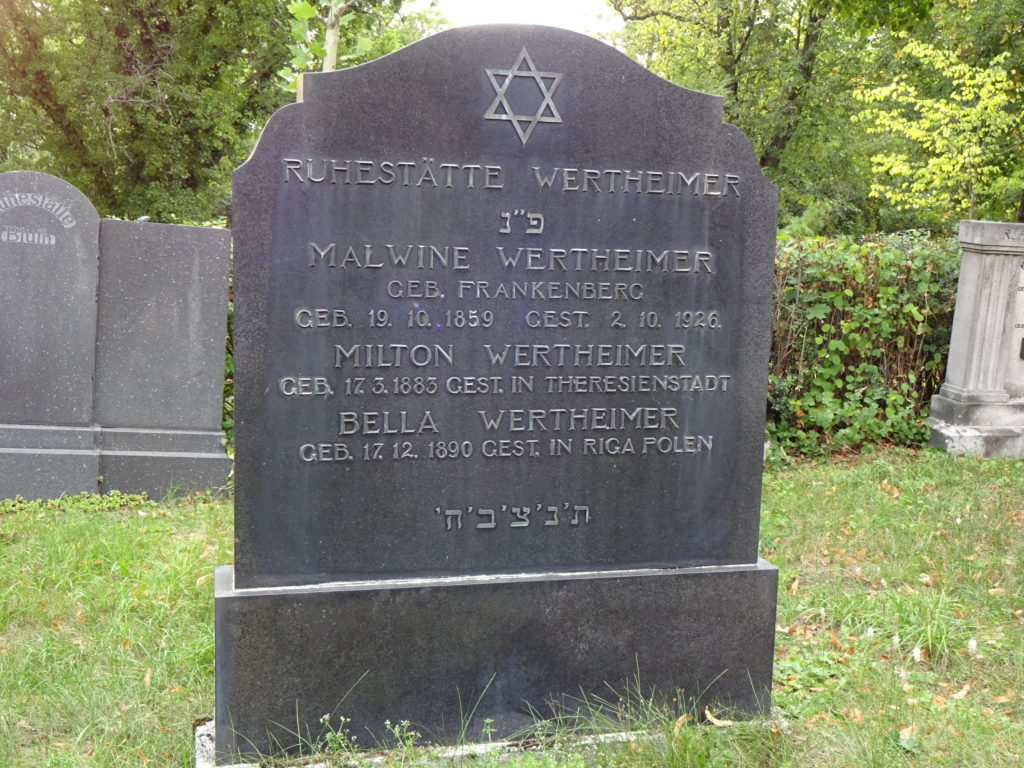
At the end of WWII, two members of the family of Nathan and Malwine Wertheimer family were alive in Europe. Lotte had survived in hiding supported by her non-Jewish husband, Erwin Meder, In September 1952, they left Holland for Johannesburg, South Africa, to join Lotte’s brother Siegbert. Erwin died in South Africa in the early 1980s; Lotte then returned to Germany to live in Frankfurt with a niece of Erwin and her family. She died in the later 1980s.
After the war, someone set up a gravestone for Malwine in the Coburg Jewish cemetery. Curiously, it honours Bella and Milton Wertheimer but makes no mention of Rosa or Julius. To date, we have not been able to confirm who sponsored the stone, or when and/or why. While the information about Bella’s fate is incorrect, and Milton’s incomplete, we believe it reflects what was known at that time. Given that the Jews deported to Belzyce Ghetto in May 1942 were all from places within what was to become the DDR (East Germany), research about this deportation only began around 2010. As well, it took time to understand the pattern of transports to Theresienstadt, which simply served as a transit camp for further transport to the killing centres at Treblinka, Sobibor, Belize, and Auschwitz. Then, for a long time, Belzyce Ghetto was assumed to be synonymous with the Belzec Killing Centre and it has taken time to clarify the difference.
****
Initially our knowledge of the family of Nathan and Malwine Wertheimer came from archival records and huge holes existed everywhere. The story of piecing together the story of Rosa and Jacob Edelmuth illustrates the process. In the 2010s, however, shortly after this website was launched, descendants of the family found it and got in touch. The first was the granddaughter of Julius Wertheimer who, while born in Themar, had spent most of his adult life in Germany in Coburg. Once in New York City after 1936, family memories focused primarily on Coburg where sons Heinz and Alfred had been born and raised. Since their paternal grandfather, Nathan, lived with them in Coburg until 1934, it’s possible that the boys only rarely, if ever, visited Themar to visit other relatives. They may never have heard of Themar.
Knowledge of the Marisfeld/Themar background came as a surprise to Pamela Wertheimer as she wrote in her first email:
“I stumbled on to this website a few weeks ago as I was doing some research on Coburg, my father, Henry Wertheimer’s birthplace.
For a long time I had no idea that my grandfather had siblings that died in concentration camp, let alone knowing that he even had siblings.
My father died in 1991. My uncle Alfred Wertheimer is still alive and is doing quite well at 83 years old. He has no memory of his father having siblings,. . “
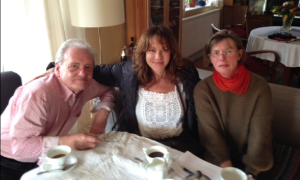 We of course were pleased to meet a Wertheimer! Pam (center in photo at left) set off for Germany later that year and included Marisfeld and Themar in her tour. Sadly, her uncle, Alfred Wertheimer, died in 2014.
We of course were pleased to meet a Wertheimer! Pam (center in photo at left) set off for Germany later that year and included Marisfeld and Themar in her tour. Sadly, her uncle, Alfred Wertheimer, died in 2014.
Several years later, the family of Rosa (née Wertheimer) and Jacob Edelmuth made contact; this time the surprise was ours as we learned of their two children and the story of life in Holland from 1933-1952. As well, a researcher in Holland, Lisa van de Beek, who initially wrote to correct an error in the information in an earlier version of this webpage, went on to provide a trove of new detail about the Nathan and Malwine Wertheimer family as well as the other Wertheimer family from Marisfeld. More members made contact from Argentina and elsewhere and so, and we have learned much more about the family of Malwine’s brother, Max Frankenberg and his family. And so, the story continues…
If you have any information or questions about the Nathan & Malwine (née Frankenberg) Wertheimer family, which you would like to share, please contact Sharon Meen @ [email protected] or [email protected]. We would all be pleased to hear from you.
*****
Below is the Descendants List for the family of Nathan & Malwine Wertheimer.
- Nathan WERTHEIMER, b. 18 Oct 1859 Marisfeld, 1939 to Holland, d. August 1942 Amsterdam
- ∞ Malvine FRANKENBERG, b. 19 Oct 1859 Marisfeld, d. 02 Oct 1926 Coburg
- 1. Julius WERTHEIMER, b. 27 May 1886 Themar, 1936 to USA, d. Jul 1971 NY/NY
- ∞ Käthe MEINSTEIN, b. 19 Feb 1896 Zirndorf, 1936 to USA, d. 12 Aug 1990 NY/NY
- 2. Heinz WERTHEIMER, b. 18 May 1926 Nürnberg, d. 03 Sep 1991 NY/NY
- 2. Alfred WERTHEIMER, b. 16 Nov 1929 Coburg, 1936 to USA, d. 19 Oct 2014 NY/NY
- 1. Rosa WERTHEIMER, b. 07 June 1887 Themar, 1939 to Holland, murdered 09 Mar 1944 Auschwitz
- ∞ Jacob EDELMUTH, b. 14 Jan 1884 Beuern, 1939 to Holland,murdered 09 Mar 1944 Auschwitz
- 2. Liselotte/Lotte EDELMUTH, b. 15 Sep 1913 Halle/Saale, 1933 to Holland, 1952 to South Africa, d. abt 1986 Frankfurt a/Main
- ∞ (1933) Edwin Georg Sigfried Karl MEDER, b. 24 May 1906 Frankfurt am Main, 1952 to South Africa, d. abt 1983 South Africa
- 2. Siegbert EDELMUTH, b. 4 Aug 1917 Coburg, [c. 1935] to South Africa, d. 03 Sep 1981 Johannesburg/SA
- 1. Bella WERTHEIMER, b. 17 Dec 1890 Themar, murdered 1942-3/Belzyce Ghetto/Lublin District
- ∞ Milton WERTHEIMER, b. 17 Mar 1886 Themar, 1936 to Holland, murdered 11 Oct1944 Auschwitz
Acknowledgments: We wish to thank
1. the family of Julius Wertheimer who have provided information, documentation, and the images of Stadtarchiv Coburg records.
2. the family of Siegbert Edelmuth for information about the Edelmuths’ time in Holland, 1926-1952 and South Africa.
3. Dr. Bernd Ulbrich of Dessau and the Stolpersteine initiative of Dessau.
4. Ms. S. Rodriguez Pereira, a volunteer at the Dutch Digital Monument, for providing the information about Milton Wertheimer in Amsterdam.
5. Ms Lisa van der Beek who provided us with documents from Dutch archives that tell the story of the Wertheimers who moved to the Netherlands: Liselotte/Lotte Edelmuth, Rosa (née Wertheimer) and Jakob Edelmuth; Nathan Wertheimer, and Milton Wertheimer. In September 2018, Ms. van de Beek was “working on a project on de Tugelaweg (a street in the former Jewish part of Amsterdam). Milton Wertheimer lived in this street at number 20 I.” Her offer to find more information in the Dutch archives has filled in critical pieces of the family story.
6. The family of Else Levy, née Frankenberg, who has wonderful photographs and of members of the Wertheimer family as well as documents that tell us much about the lives of all the Wertheimers and Frankenbergs from Coburg.
7. Ms. Gaby Schuller of Coburg who is documenting the story of the Frankenbergs and Wertheimers (and other Themar families with connections to Coburg) with photographs and on-the-spot research.
Sources:
Alemannia-judaica Friedhof, Coburg.
Ancestry.com. U.S., World War II Draft Registration Cards, 1942 [database on-line]. Provo, UT, USA: Ancestry.com Operations, Inc., 2010.
Deutsches Bundesarchiv, Gedenkbuch.
Gedenkkultur Dessau-Rosslau.
Stadtarchiv Coburg. Registerblatt für das Wohnungsregister Coburg.
Werkstatt Gedenkkultur. STOLPERSTEINE für Dessau-Roßlau Ein Beitrag zur lokalen Gedenkkultur. Dessau, 2008.